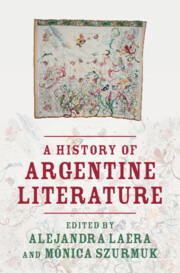Book contents
- A History of Argentine Literature
- A History of Argentine Literature
- Copyright page
- Contents
- Figures
- Contributors
- Editors’ Acknowledgments
- Introduction
- Part I Literary Dates
- Part II Critical Inroads
- Part III Literary Names
- Chapter 21 Sarmiento: Politics, Culture, and Spectacle
- Chapter 22 The Mansilla Siblings: A Story in Syntony
- Chapter 23 Martín Fierro: Subaltern Voices
- Chapter 24 Borges and Argentine Literature: A Detour around the World
- Chapter 25 Roberto Arlt
- Chapter 26 The Ocampo Sisters
- Chapter 27 Alfonsina Storni and Alejandra Pizarnik
- Chapter 28 Displacement and Transfer in Julio Cortázar’s Todos los fuegos el fuego
- Chapter 29 Manuel Puig’s Circuit Bending: Literary Listening against Surveillance
- Chapter 30 Operation Massacre: Dangerous Journalism
- Chapter 31 The Politics of the Poem: From Gelman to Perlongher
- Chapter 32 Scenes from Postmodern Life: Literary Interventions in the Public Sphere
- Chapter 33 Griselda Gambaro and Beyond: A “Dermography” of Contemporary Women’s Theater and Performance
- Chapter 34 César Aira and the Art of Invention
- Index
- References
Chapter 27 - Alfonsina Storni and Alejandra Pizarnik
from Part III - Literary Names
Published online by Cambridge University Press: 09 May 2024
- A History of Argentine Literature
- A History of Argentine Literature
- Copyright page
- Contents
- Figures
- Contributors
- Editors’ Acknowledgments
- Introduction
- Part I Literary Dates
- Part II Critical Inroads
- Part III Literary Names
- Chapter 21 Sarmiento: Politics, Culture, and Spectacle
- Chapter 22 The Mansilla Siblings: A Story in Syntony
- Chapter 23 Martín Fierro: Subaltern Voices
- Chapter 24 Borges and Argentine Literature: A Detour around the World
- Chapter 25 Roberto Arlt
- Chapter 26 The Ocampo Sisters
- Chapter 27 Alfonsina Storni and Alejandra Pizarnik
- Chapter 28 Displacement and Transfer in Julio Cortázar’s Todos los fuegos el fuego
- Chapter 29 Manuel Puig’s Circuit Bending: Literary Listening against Surveillance
- Chapter 30 Operation Massacre: Dangerous Journalism
- Chapter 31 The Politics of the Poem: From Gelman to Perlongher
- Chapter 32 Scenes from Postmodern Life: Literary Interventions in the Public Sphere
- Chapter 33 Griselda Gambaro and Beyond: A “Dermography” of Contemporary Women’s Theater and Performance
- Chapter 34 César Aira and the Art of Invention
- Index
- References
Summary
Primarily poets, writers Alfonsina Storni and Alejandra Pizarnik had in common being daughters of immigrants, and both committed suicide. Storni’s poetry during her lifetime was popular and accessible, with topics of women, love, and modernity. Poet, journalist, dramatist, and maestra (schoolteacher), she gained early fame but only partial critical success. She crafted a defiant public image and even staged her suicide after a long struggle with cancer. She protested the stigma of being an unwed mother and other injustices borne by women. In contrast, Pizarnik initially reached a smaller but influential reading public; many young readers identify with her elusive and fractured poetry-theater of interiority. Rebellious and bisexual, she was the daughter of Jews who had escaped the Holocaust but lost their world. Loss, mourning, and sometimes violence, abjection, and terror are recurring topics, as in The Bloody Countess. As with Storni, there is confessionalism, but Pizarnik’s “I” is not a stable subject but a wandering marker, emphasizing the body, sexual desire, and fragmentation. Pizarnik’s struggle with language becomes a battle against the breakdown of the world.
- Type
- Chapter
- Information
- A History of Argentine Literature , pp. 422 - 438Publisher: Cambridge University PressPrint publication year: 2024

